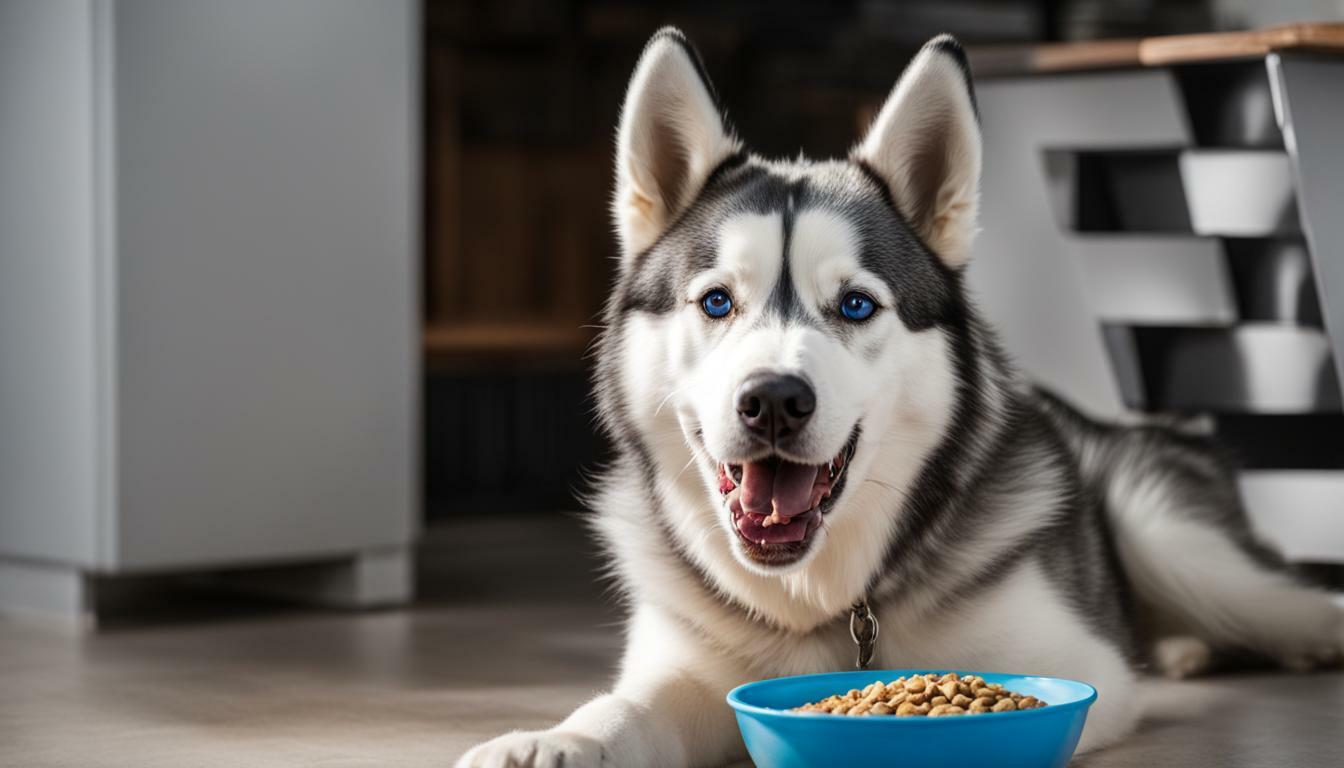Feeding your Husky the right amount of food is crucial for their overall health and well-being. Huskies are known for their high energy and stamina, so it’s important to provide them with the proper nutrition they need to thrive. In this guide, we will explore Husky feeding guidelines to help you determine how much food to give your furry friend.
When it comes to feeding Husky puppies, the amount of food they need per day varies based on their age. For young puppies, it can range from 3.5 to 30 ounces of food. As they grow older, the number of meals per day will decrease. It’s important to feed them age-appropriate portions to support their growth and development.
Huskies have specific dietary needs. They require a high amount of protein, preferably sourced from animal proteins, to support their active lifestyle. Fillers like corn, wheat, and soy should be avoided, as they provide less nutritional value. While raw and homemade diets are options, commercial dry kibble is convenient and contains essential nutrients.
Male Huskies typically need slightly more food than females, but it’s essential to find the right balance for your individual dog. Underfeeding or overfeeding can lead to health issues, so it’s important to monitor their weight and adjust their food intake accordingly. During their growth stage, Huskies should have a lean and lanky appearance.
Transitioning your Husky from puppy food to adult food should be done gradually to avoid any digestive issues. It’s important to provide a variety of foods to keep them interested in their meals. Wet food, lean meats, organ meats, and bones can be added to their diet to provide important nutrients and prevent boredom.
As your Husky becomes a senior, their food intake should be adjusted accordingly. Specially-made commercial foods tailored for senior dogs are recommended to support their aging bodies. Monitoring their overall health is important, as certain health issues may require special dietary considerations.
It’s important to be aware of common food allergies in Huskies and avoid ingredients that may trigger an allergic reaction. Wheat, certain animal proteins, and other potential allergens should be taken into consideration when choosing their food.
When it comes to Siberian Huskies specifically, they typically require 2-4 cups of food per day. Their meals should be divided into two servings for adult dogs. Puppies will need to be fed three times a day initially and gradually transitioned to two meals.
Factors such as growth and development, exercise levels, and overall health should be considered when determining how much to feed your Husky. Adjusting their food intake based on these factors will help ensure they receive the right amount of nutrition for their specific needs.
In conclusion, finding the perfect balance in feeding your Husky is crucial. By following Husky feeding guidelines and considering their individual needs, you can ensure your furry friend stays happy, healthy, and well-nourished.
Understanding Husky Feeding Guidelines
Huskies have specific dietary needs that require careful consideration to keep them healthy and happy. Feeding your Husky a proper diet is essential for their overall well-being. To ensure your furry friend receives the nutrition they need, it’s important to understand Husky feeding guidelines.
Huskies thrive on a diet that is rich in protein. Protein should be the main component of their meals, preferably sourced from animal-based ingredients. Avoid fillers such as corn, wheat, and soy, as these can be difficult for Huskies to digest. Additionally, a diet with a proper balance of vitamins, minerals, and carbohydrates is vital for their energy levels and overall health.
While some owners choose to feed their Huskies a raw or homemade diet, commercial dry kibble is a convenient and reliable option. Look for high-quality dog food brands that meet the nutritional needs of Huskies. These brands often include a blend of protein-rich meats, vegetables, and grains to ensure a well-rounded diet for your Husky.
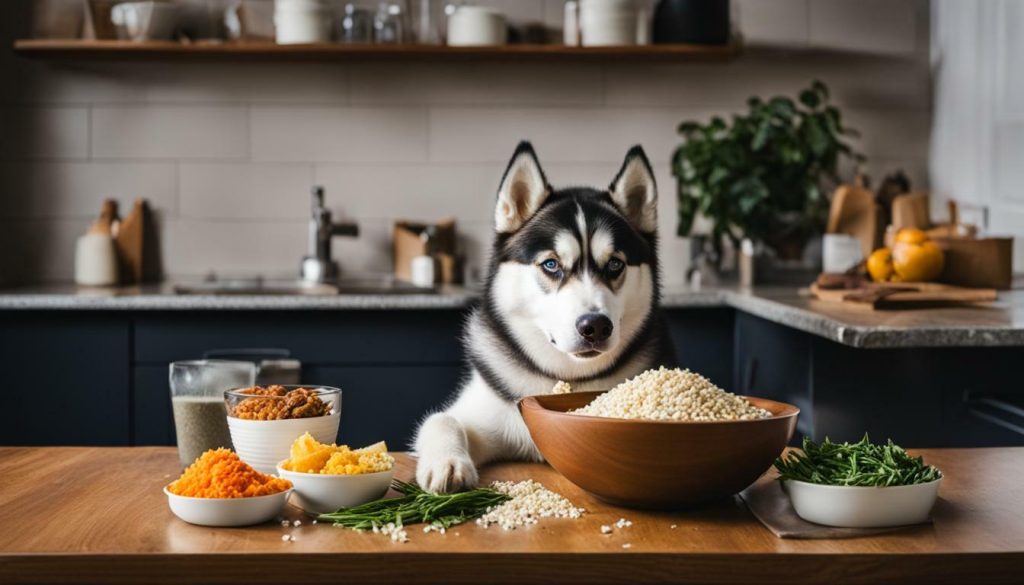
Determining Portion Sizes for Huskies
Finding the right balance of food portions is essential to ensure your Husky maintains a healthy weight and energy level. Portion sizes for Huskies can vary depending on factors such as age, energy levels, and size. It’s important to consider these factors when determining how much to feed your Husky to ensure they are getting the proper nutrition they need.
For puppies, the quantity of food per day varies based on age. Younger puppies may require smaller, more frequent meals, while older puppies can begin transitioning to larger, less frequent meals. A general guideline for Husky puppies is to feed them between 3.5 to 30 ounces of food per day, divided into three meals. As they grow older, the number of meals per day can be gradually reduced to two.
| Age | Food Quantity per Day | Number of Meals per Day |
|---|---|---|
| 8-12 weeks | 3.5-8 ounces | 3 |
| 3-6 months | 8-12 ounces | 3 |
| 6-12 months | 12-24 ounces | 2-3 |
As adult Huskies reach their full size, their portion sizes should be adjusted accordingly. On average, adult Huskies require about 2-4 cups of food per day, divided into two servings. However, it’s important to remember that every Husky is unique, and their individual needs may vary.
Factors to Consider for Portion Sizes
When determining portion sizes for your Husky, there are several factors you should consider:
- Growth and development: Young Huskies may require more food to support their growth, while adult Huskies may need less to maintain their weight.
- Exercise levels: Huskies are an active breed and require regular exercise. If your Husky is highly active, they may require slightly larger portion sizes to sustain their energy levels.
- Overall health: If your Husky has any health conditions or is prone to weight gain, it’s important to consult with your veterinarian for specific feeding recommendations.
By considering these factors and monitoring your Husky’s weight and energy levels, you can adjust their portion sizes accordingly to ensure they remain happy and healthy.
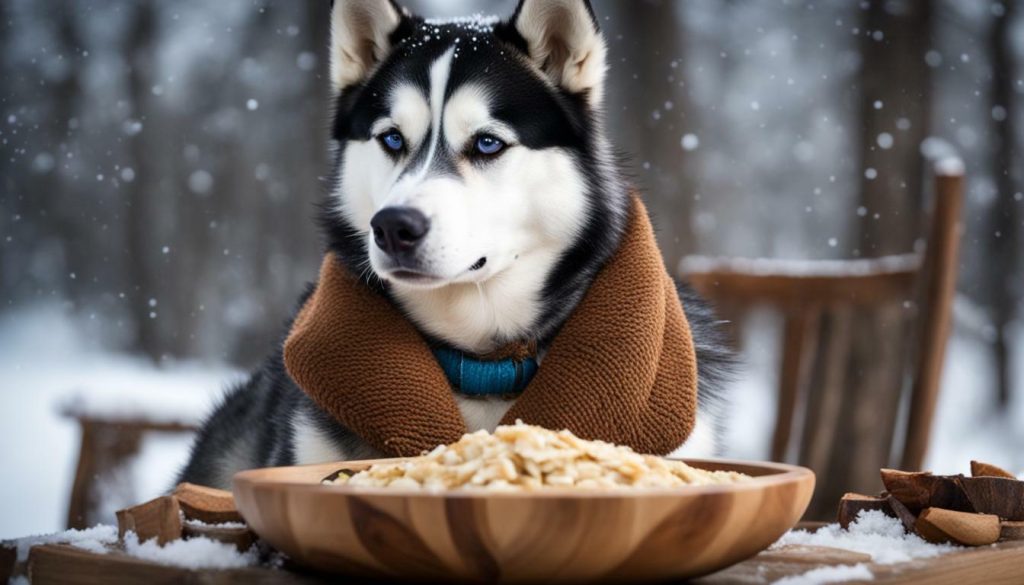
As your Husky grows, their nutritional needs change, requiring a shift from puppy food to adult food. It’s essential to transition them gradually to avoid any digestive issues. Puppy food is formulated to support their rapid growth and development, while adult food is designed to meet their maintenance requirements.
The transition process should be done over a period of 7-10 days. Start by mixing a small amount of adult food into their puppy food, gradually increasing the ratio of adult food to puppy food each day. This allows their digestive system to adjust to the new diet without causing any discomfort.
When selecting adult food for your Husky, look for options that provide a balance of high-quality protein, healthy fats, and carbohydrates. The protein should preferably come from animal sources such as chicken, turkey, or fish. Avoid foods that contain fillers like corn, wheat, and soy as they offer little nutritional value.
| Age | Transition Schedule | Recommended Daily Food Intake |
|---|---|---|
| 2-4 months | 25% adult food, 75% puppy food | 4-8 ounces |
| 4-6 months | 50% adult food, 50% puppy food | 8-12 ounces |
| 6-10 months | 75% adult food, 25% puppy food | 12-16 ounces |
| 10 months and older | 100% adult food | 2-4 cups |
Transitioning your Husky from puppy to adult food is an important step in their nutritional journey. By gradually introducing adult food and selecting high-quality options, you can ensure that your Husky receives the right nutrients to support their overall health and well-being.
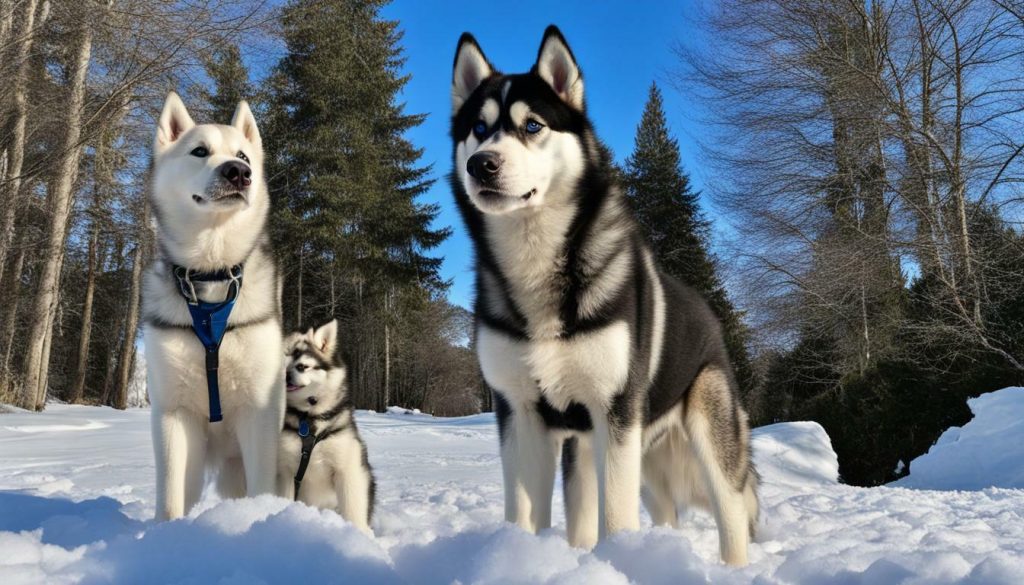
It’s important to monitor your Husky during the transition process and adjust their food intake based on their energy levels and body condition. Each Husky is unique, so it’s essential to pay attention to their individual needs.
Remember to provide fresh water at all times and consult with your veterinarian if you have any concerns or questions about transitioning your Husky from puppy to adult food. They can provide personalized recommendations based on your Husky’s specific needs and ensure a smooth transition.
Adding Variety to Your Husky’s Diet
Keeping mealtime interesting and nutritious is key to a happy and healthy Husky. Adding variety to their diet not only keeps them excited about eating but also ensures they receive a wide range of essential nutrients. Here are some tips to add variety to your Husky’s meals:
1. Incorporate wet food: Adding canned wet food to your Husky’s meals can enhance the taste and texture of their food. Look for high-quality wet food options that contain real animal proteins and avoid fillers like corn, wheat, and soy. Wet food can also help keep your Husky hydrated, especially during warmer months.
2. Include lean meats: Lean meats like chicken, turkey, and beef can be a nutritious addition to your Husky’s diet. Cooked and deboned meats provide protein and essential amino acids that support muscle development and overall health. Make sure to remove any skin, fat, or bones before serving.
| Meat Options | Benefits |
|---|---|
| Chicken | High in protein and low in fat |
| Turkey | Rich in essential amino acids and vitamins |
| Beef | Provides iron, zinc, and B-vitamins |
Quote: “Adding variety to your Husky’s diet not only keeps them excited about eating but also ensures they receive a wide range of essential nutrients.”
3. Incorporate organ meats: Organ meats like liver, kidney, and heart are highly nutritious for Huskies. They are packed with vitamins, minerals, and essential fatty acids that can support your Husky’s overall health and well-being. Make sure to source organ meats from reputable suppliers and cook them thoroughly before serving.
4. Offer bones for chewing: Raw, meaty bones can provide dental benefits for your Husky while also satisfying their natural urge to chew. However, it’s important to choose appropriate-sized bones and supervise your Husky during chewing to prevent any choking hazards. Consult with your veterinarian to determine the best bone options for your Husky.
Husky Feeding Schedule
When it comes to feeding your Husky, maintaining a consistent schedule is essential. Dogs thrive on routine, and having set mealtimes can help regulate their digestion and prevent overeating. Here’s a recommended feeding schedule for your Husky:
| Age | Feeding Frequency |
|---|---|
| Puppy (up to 6 months) | 3 meals a day |
| Puppy (6-12 months) | 2 meals a day |
| Adult (1 year and older) | 2 meals a day |
Remember, each Husky is unique, and their dietary needs may vary. It’s important to monitor their weight, energy levels, and overall health to determine the right amount of food and feeding frequency for your individual Husky. Consult with your veterinarian for personalized recommendations based on your Husky’s specific needs.

As your Husky enters their senior years, adjustments to their diet become necessary to support their overall well-being. Senior Huskies have different nutritional needs compared to younger dogs, and it’s important to provide them with the right amount of food to maintain their health and vitality.
One of the key considerations for feeding senior Huskies is their reduced activity levels. With age, their energy requirements decrease, so it’s crucial to adjust their food intake accordingly. Senior Huskies may also experience changes in their metabolism and digestion, making it important to choose easily digestible food options.
When it comes to portion sizes for senior Huskies, it’s best to consult with your veterinarian. They can assess your dog’s health, weight, and activity levels to determine the appropriate amount of food. In general, senior Huskies may require smaller portion sizes compared to their younger counterparts.
| Age | Food Amount (Cups) |
|---|---|
| 7-10 years | 2-3 |
| 10+ years | 1.5-2.5 |
It’s important to monitor your senior Husky’s weight and body condition regularly and make adjustments to their food intake as needed. Observe their energy levels, coat condition, and overall well-being to ensure they’re receiving the proper nutrition.
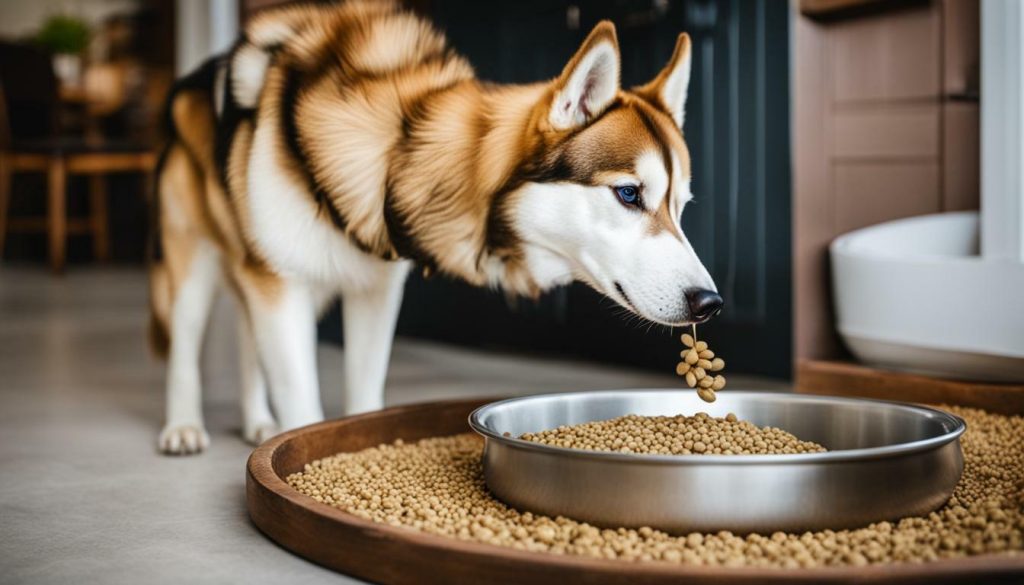
Remember, every Husky is unique, so it’s essential to consider their individual needs when adjusting their food intake. Regular vet check-ups and discussions about their diet can help ensure that your senior Husky remains healthy, active, and happy in their golden years.
Common Food Allergies in Huskies
Food allergies can pose challenges for Husky owners, but with the right knowledge, you can ensure your furry friend stays healthy and allergy-free. It’s important to be aware of common food allergens and take necessary precautions to avoid them in your Husky’s diet. Some of the most common food allergies in Huskies include wheat, certain animal proteins, and artificial additives.
Wheat is a common allergen for dogs, including Huskies. It can cause digestive issues, skin problems, and discomfort. To avoid wheat allergies, it’s best to choose dog food that is wheat-free or opt for alternative grains that are less likely to cause allergic reactions.
Animal proteins such as beef, chicken, and lamb can also trigger food allergies in Huskies. In some cases, it may be necessary to avoid these proteins altogether and opt for alternative protein sources like fish or duck. Always read the ingredient label on dog food carefully to ensure it does not contain any allergenic proteins.
Food Allergy Symptoms in Huskies
Identifying food allergy symptoms in your Husky is crucial for their well-being. Common symptoms of food allergies in Huskies include:
| Symptoms | Description |
|---|---|
| Itchy skin | Your Husky may constantly scratch, lick, or chew their skin. |
| Ear infections | Recurrent ear infections can be a sign of food allergies. |
| Vomiting or diarrhea | Food allergies can cause digestive upset in Huskies. |
| Redness or inflammation | Your Husky’s skin may become red, inflamed, or develop rashes. |
| Excessive shedding | Your Husky may experience increased hair loss due to food allergies. |
If you notice any of these symptoms in your Husky, consult with your veterinarian for an accurate diagnosis and proper treatment. Your vet may recommend an elimination diet or allergy testing to determine the specific food allergens affecting your Husky.
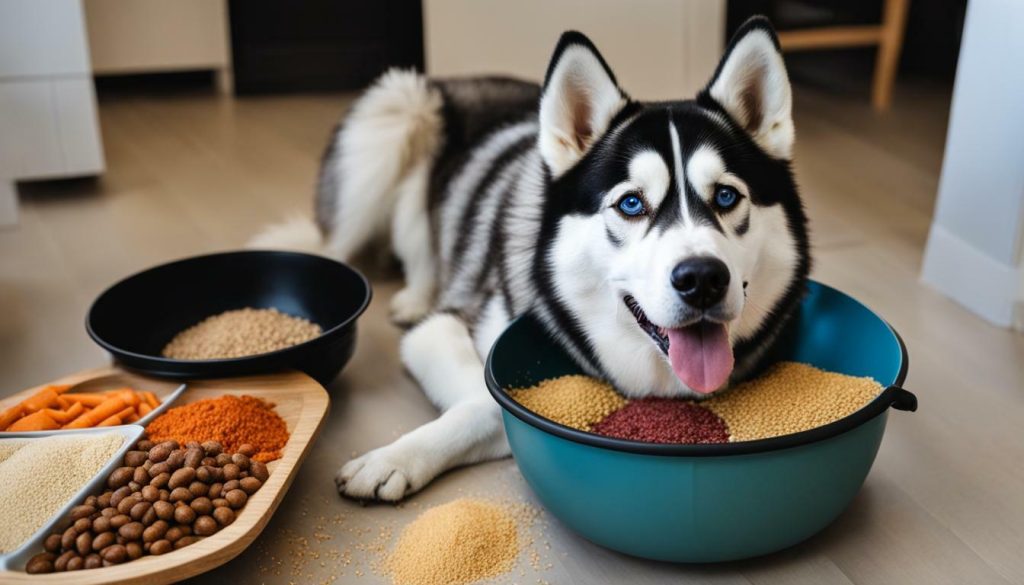
Siberian Huskies have unique feeding requirements that play a vital role in their overall well-being. To ensure they receive the proper nutrition, it’s essential to feed them according to a regular schedule and avoid overfeeding or underfeeding. Siberian Huskies typically require 2-4 cups of high-quality dog food per day, divided into two servings for adult dogs. Puppies, on the other hand, need to be fed three times a day and gradually transitioned to two meals as they grow.
When it comes to choosing the right type of food for your Siberian Husky, you have options. Commercial dry kibble formulated for active breeds is a convenient and balanced choice. Alternatively, you can opt for home-cooked meals prepared with the guidance of a veterinary nutritionist. Whichever option you choose, it’s important to ensure the food meets their nutritional needs, including a high amount of protein sourced from animals. Avoid fillers like corn, wheat, and soy, which can lead to digestive issues.
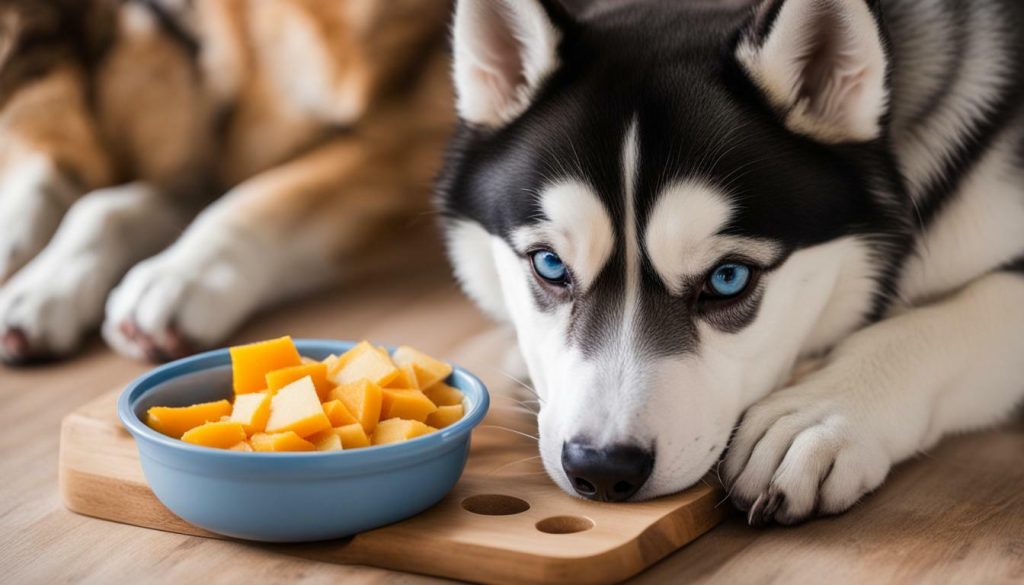
It’s important to be aware of potential food allergies in Siberian Huskies. Wheat and certain animal proteins are common allergens, so it’s best to avoid these ingredients. Signs of food allergies can include gastrointestinal upset, skin rashes, and excessive scratching. If you suspect your Husky has a food allergy, consult with your veterinarian to develop an appropriate diet plan.
| Age | Meal Frequency |
|---|---|
| Puppies | 3 times per day |
| Adults | 2 times per day |
When determining the amount of food to feed your Siberian Husky, consider their growth and development, exercise levels, and overall health. If your Husky is highly active and has a faster metabolism, they may require more calories. Conversely, if they are less active or prone to weight gain, you may need to adjust their food intake accordingly. Regular monitoring of their body condition and weight is important to ensure they maintain a healthy and lean physique.
In conclusion, feeding your Siberian Husky according to their unique requirements is crucial for their well-being. By providing them with the right amount of high-quality food, divided into appropriate servings, you can ensure they receive the nutrition they need to thrive. Additionally, being mindful of potential food allergies and adjusting their diet as they age will help maintain their health and happiness.
Factors to Consider When Determining Food Amounts
Calculating the right amount of food for your Husky involves considering several crucial factors that contribute to their overall health. These factors include their growth and development, exercise levels, and overall health condition. It’s essential to ensure that your Husky receives the appropriate amount of nutrition to support their high energy levels and maintain optimal body condition.
When determining the food quantity for your Husky, it’s important to take into account their stage of life. Husky puppies require more food compared to adult Huskies due to their rapid growth. As they mature, their food intake will gradually decrease. The recommended daily food portion for Husky puppies can range from 3.5 to 30 ounces, depending on their age. It’s important to monitor their body condition and adjust the portion sizes accordingly.
Another important consideration is the energy level of your Husky. Huskies are an active breed and require a diet that provides them with sufficient energy to support their daily activities. If your Husky is highly active and engages in regular exercise or participates in activities such as dog sports or sledding, they may require a slightly higher food intake compared to a less active Husky.
Ultimately, the specific needs of your Husky will vary based on their individual characteristics. It’s crucial to monitor their body condition regularly to ensure they are maintaining a healthy weight. Adjusting the food portion sizes accordingly can help prevent underfeeding or overfeeding, which can lead to health issues in the long run. Consulting with a veterinarian can provide valuable insight into your Husky’s specific dietary needs and help you develop a feeding plan that suits them best.
| Factors to Consider | Food Amount Recommendations |
|---|---|
| Growth and Development | Higher food intake for puppies; gradual decrease as they mature |
| Exercise Levels | Adequate food portion to support their active lifestyle |
| Overall Health Condition | Adjustments based on maintaining a healthy weight |
Quote:
“Properly calculating the right amount of food for your Husky is crucial for their overall health and well-being.”
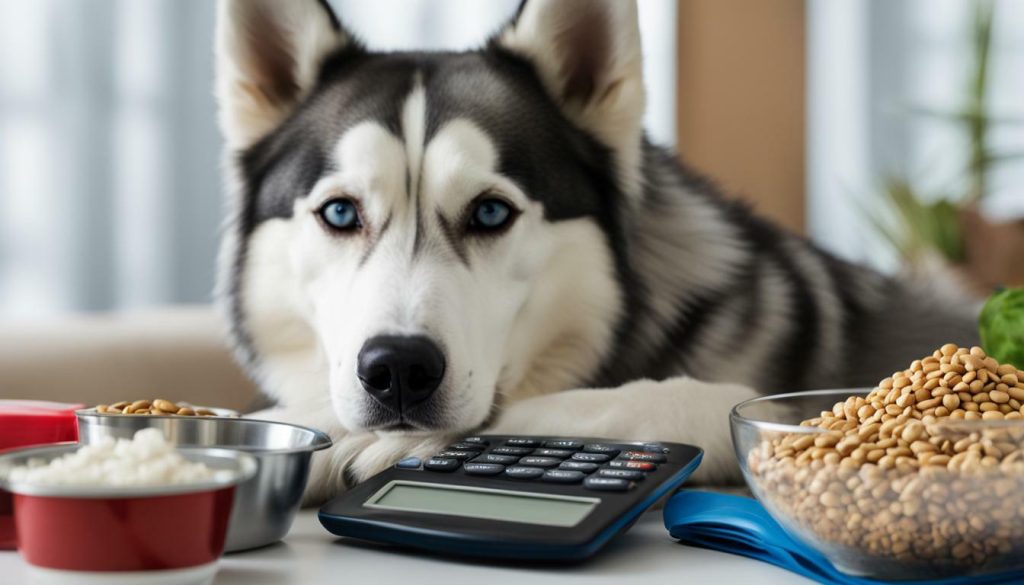
Feeding your Husky the right way is a vital aspect of ensuring their optimal health and happiness. As a high-energy breed, Huskies require a carefully balanced diet to support their active lifestyle. By following the right Husky feeding guidelines and understanding their nutritional needs, you can provide your furry friend with the nourishment they need to thrive.
When it comes to determining portion sizes for Huskies, factors such as age, energy levels, and size play a significant role. It’s essential to avoid underfeeding or overfeeding, as Huskies should maintain a lean and lanky appearance during their growth stage. By monitoring their energy levels and adjusting the amount of food accordingly, you can ensure they receive the right balance of nutrients.
Adding variety to your Husky’s diet is another key aspect to consider. Providing different types of food, such as wet food, lean meats, organ meats, and bones, not only keeps them interested in their meals but also offers essential nutrients. Just remember to introduce new foods gradually and keep an eye out for any signs of food allergies or sensitivities.
As your Husky grows older, their nutritional needs change. Senior Huskies may require a decrease in their food intake, and specially-made commercial foods tailored for seniors can provide the necessary nutrients. It’s important to be aware of common food allergies in Huskies and avoid ingredients that may trigger an allergic reaction.
Ultimately, finding the perfect balance in feeding your Husky is a journey of understanding their individual needs. Consider their growth and development, exercise levels, and overall health when making feeding decisions. By following the Husky feeding guidelines and regularly assessing their dietary requirements, you can ensure your beloved companion stays healthy, happy, and full of energy.
FAQ
Q: How much should I feed my Husky puppy?
A: The quantity of food for Husky puppies varies by age, ranging from 3.5 to 30 ounces per day. As they get older, the number of meals per day decreases. It is important to feed them according to their age and size.
Q: What kind of food should I feed my Husky?
A: Huskies need food with a high amount of protein, preferably sourced from animals. It is best to avoid filler ingredients like corn, wheat, and soy. While raw and homemade diets are an option, commercial dry kibble is convenient and contains essential nutrients.
Q: Do male and female Huskies require different amounts of food?
A: Male Huskies typically need slightly more food than females. It is important to consider their individual energy levels and size when determining the right amount of food to feed them.
Q: How should I transition my Husky from puppy to adult food?
A: Transitioning from puppy to adult food should be done slowly. Gradually mix in the new food over a period of time to allow their digestive system to adjust. This will help prevent any digestive issues.
Q: Can I add variety to my Husky’s diet?
A: Yes, variety can be added to your Husky’s diet to keep them interested in their meals. You can incorporate wet food, lean meats, organ meats, and bones to provide essential nutrients. This can help prevent boredom and ensure they are getting a balanced diet.
Q: How much should I feed my senior Husky?
A: Seniors usually require a decrease in their food intake. There are specially-made commercial foods tailored for seniors that you can consider. It is important to monitor their weight and adjust their food intake accordingly to maintain their health during their golden years.
Q: Are there any common food allergies in Huskies?
A: Yes, food allergies are common in Huskies. It’s important to avoid ingredients like wheat and certain animal proteins if your Husky has known allergies. Be aware of any signs of food allergies, such as skin rashes or gastrointestinal issues, and adjust their diet accordingly.
Q: How much food should I feed my Siberian Husky?
A: Siberian Huskies typically require 2-4 cups of food per day. Their meals should be divided into two servings for adults. Puppies may need to be fed three times a day initially and gradually transitioned to two meals as they get older.
Q: What factors should I consider when determining how much to feed my Husky?
A: Factors to consider include growth and development stage, exercise levels, and overall health. It is important to assess their energy levels, body condition, and adjust the food amount accordingly to maintain a lean and healthy physique.
Q: How do I find the perfect balance in feeding my Husky?
A: Finding the perfect balance involves meeting the nutritional needs of your Husky while considering their individual factors. It’s important to provide a balanced diet, monitor their weight, and make adjustments as needed to ensure their overall health and well-being.
